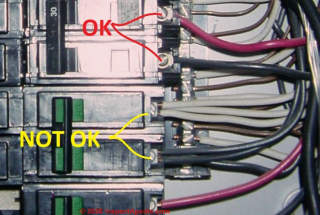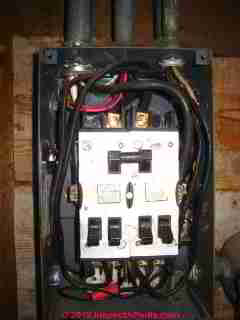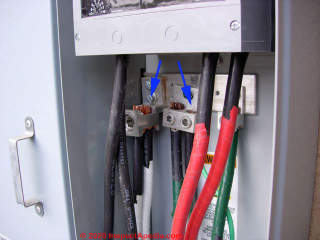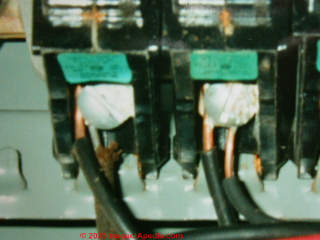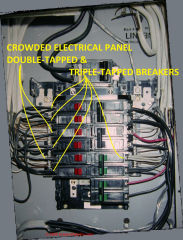 Double-Tapped Circuit Breaker Hazards
Double-Tapped Circuit Breaker Hazards
Double Lugging = two or more electrical wires under one screw: OK or not OK?
- POST a QUESTION or COMMENT about multiple wires connected under one screw at circuit breakers and other electrical devices
This article defines and describes double-tapping: the practice of connecting two or more electrical wires under one screw at a circuit breaker or other electrical devices. We provide several examples of double tapping, triple-tapping, even multiple taps at individual circuit breaker electrical connectors that were not or may not have been designed to accept more than one wire.
Depending on the design of the connector where double tapped wires are found, double-tapping may produce an un-reliable and unsafe electrical connection.
Page top photo: an over-crowded electrical panel illustrates two and even three wires jammed under the screw connector of most of the circuit breakers. The manufacturer's design of these circuit breaker connectors did not anticipate, intend, nor approve of so many wires under one connector.
These connections are unreliable and in some installations are downright unsafe as we will explain.
InspectAPedia tolerates no conflicts of interest. We have no relationship with advertisers, products, or services discussed at this website.
- Daniel Friedman, Publisher/Editor/Author - See WHO ARE WE?
Double Tapped Circuit Breaker Connections
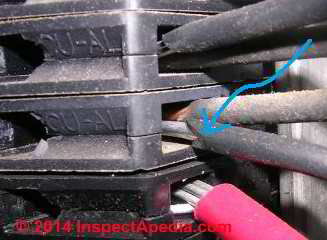 Watch out: double-tapping electrical wire connections such as we illustrate here is improper and unsafe unless the connector is specifically designed for that purpose and is so-indicated by its manufacturer.
Watch out: double-tapping electrical wire connections such as we illustrate here is improper and unsafe unless the connector is specifically designed for that purpose and is so-indicated by its manufacturer.
Our photograph shows a close-up image of double-tapped aluminum and copper wires under one screw at a circuit breaker.
[Click to enlarge any image]
This is an improper and unsafe electrical connection.
In this photo of wires inserted into several circuit breakers, even without any disassembly we can see a solid conductor aluminum wire (blue arrow) double-tapped (two wires under one connector) along-side a copper (or tinned copper) wire into a circuit breaker.
We see a copper wire and on top of it a silver-colored electrical wire that is probably solid conductor aluminum wire. The CU-AL rating stamped into the circuit breaker may itself not have been based on independent testing but more, it is unlikely that the manufacturer intended the circuit breaker to handle both AL and CU wires at once.
Common problems I've found in multi-tapped circuit breakers and some other electrical connections include:
- The double- or triple-tapped circuit breaker connection is unreliable:
tightening the circuit breaker or other device screw will sometimes pinch and bind against one wire while leaving others under the screw loose, risking loss of electrical power
- A multi-tapped electrical connection may overheat, risking fire
where electrical wires are loose or poorly-connected there is a risk of electrical arcing, or more subtle, micro-fretting.
The carbon deposits left by these arcs or microscopic arcing forms an insulation that leads to overheating, loss of electrical power and in severe cases, an electrical panel fire such as is illustrated by a field report detailed
at CUTLER HAMMER ELECTRICAL PANELS. - The double tap electrical connection may violate electrical codes:
unless the manufacturer specifically designed a connector to hold multiple electrical wires, putting more than one wire into the connector is improper and is a violation of the electrical code (failure to follow the manufacturer's installation specifications). - Double lugging or double tapping overloads the circuit breaker.
If the circuit breaker is overloaded it will repeatedly warm to the point of tripping, leading to loss of electrical power on the affected circuits. - Double tapping can indicate overcrowded electrical panel:
The double tapped electrical connection, or in the case of our page top photo the triple-tapped electrical connections in an electrical panel are a sign that the electrical panel is over-crowded.
Over-crowding is likely to mean that more wires and devices are in the panel than were permitted based on the panel's size, another source of overheating, of having to jam wires into the panel thus sometimes loosening or damaging connections or wires or devices, risking electrical failures and potentially an electrical fire.
Watch out: In addition to the improper double-tapping in the center circuit breaker shown above, copper wire in contact with an aluminum conductor in an AL-CU rated circuit breaker is not covered by the UL-listing. The device is listed for use with either copper-only or aluminum only.
Below: additional examples of double tapping and triple tapping at circuit breakers: a poor practice in many installations.
The 240VAC breakers above show examples of proper wiring (marked OK in red) and improper wiring (marked NOT OK in yellow).
Below is an older Federal Pacific Electric copper-bus electrical panel.
Above: this antiquated FPE electrical panel appears to use a copper bus, it is cramped, appears to be double-tapped, possibly improperly wired, and obsolete.
Improper double-tapping or multi-tapping may be found in numerous locations in an electrical panel such as
- At individual circuit breaker terminals
- At the neutral bus
- Even at the main breaker lugs or even ahead of the main breaker where power enters the electrical panel, as we illustrate next.
Below is a particularly dangerous example of double tapping: someone has connected a #12 or #14 circuit (rated for 20A or 15A) right under the main lugs in the electrical panel.
Watch out: this is in essence an un-fused or at least grossly-over-fused electrical circuit that is inviting a building fire. The double-tapped added-on circuit wires are not properly protected against over-current.
Below: another example of double-lugging at the electrical panel mains, provided courtesy of an InspectApedia.com reader.
And in an interesting example of double-tapping under circuit breaker screws we see also an instance of overheating - below.
How to Fix an Improperly-Double Lugged (Double-Tapped) Circuit Breaker
Provided the electrical panel has sufficient working space, your electrical inspector will usually approve the following solution to double-tapped breakers:
- Remove the two or more double-lugged or multi-tapped wires from the circuit breaker.
- Use a pigtail connector:
Provided that the total load of the two (or more) circuits will not overload the breaker when in use, and provided that all of the wires on the circuits involved are of the same ampacity rating and size, join the wires together with an accepted splicing device such as a twist-on connector, including a single-wire pigtail that connects the splice to the circuit breaker. - Split up the load:
If the total load of the double-lugged wires at the breaker will overload the breaker then you need to keep the wires separate, attaching each to its own dedicated circuit breaker in the electrical panel or load center. - Add an external junction box:
If the load center does not have sufficient working space for the splicing your electrical inspector may accept the use of a junction box mounted outside of the electrical panel where the circuits can be spliced to a single pigtail that then is connected to the circuit breaker, again presuming that the total won't overload the breaker. - Add a larger load center or a sub panel:
If the load center does not have sufficient space to mount additional circuit breakers to host each of the split-up previously-double-tapped circuit wires then you will need either a larger load center or your electrician may install a sub panel with additional breakers, fed out of the existing panel.
Some Circuit Breakers are Designed to Accept Two Wires
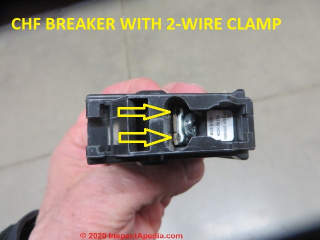 Are all cases of double-tapping improper and illegal?
Are all cases of double-tapping improper and illegal?
No. In the U.S. two manufacturers, Eaton Cutler Hammer QO & QOB and certain Square D circuit breakers use connectors designed to accept two wires under the same screw or lug.
The Cutler Hammer CHF breaker shown here has, under the breaker screw, a clamp designed to accept two electrical wires.
Watch out: however: when inserting two individual wires under this type of circuit breaker clamp, one at each side of the screw, there are some common mistakes to avoid:
- The two wires must both be the size
If instead you inserted a #12 wire on one side of this clamp and a #14 on the other, as the screw is tightened down it is likely to stop after having bound the larger #12 wire, leaving the #14 wire loose. I've pulled such wires right out of the breaker with no effort at all, and I've also encountered arcing and overheating at such connections.
OPINION: And if someonel inserts a copper wire together with a solid conductor aluminum wire under this clamp, even if both wires are the same size (which is unlikely) that connection is improper and unsafe, inviting corrosion and overheating because of the dissimilar metals and because the connector was not designed nor intended to make an aluminum-copper splice.
Watch out: Notwithstanding the AL/CU designation stamped on some devices and seen in the termination table given below, we have found no independent testing nor any publicly-available industry report of testing that has demonstrated safe use of a circuit breaker pressure plate to join aluminum and copper wires.
We do not recommend mixing aluminum and copper using ANY connector other than those recommended by the US CPSC and cited at
ALUMINUM WIRING REPAIR METHODS
- Take care to keep both wires fully inserted under the clamp while tightening the circuit breaker connecting screw.
In comparison, placing two wires, one on either side, of a conventional older type circuit breaker screw that does not use a clamp such as the one shown by the yellow arrows, as the screw is turned clockwise it will tend to pull one of the wires more securely into the connection while it will tend to push the other wire out of the connection. - Follow the manufacturers wire size and combination restrictions:
Square D QO/QOB circuit breakers with a pressure plate or clamp designed and rated to accept two wires can be wired in these two combinations:
1 - #14 through #8 wire or
2 - #14 through #10 wire
Watch out: as we cite below and as Schneider Electric points, out, while the company's QO/QOB circuit breakers ( QO and QOB, 1-, 2- and 3-poles, 10A through 30A) are rated to accept 2 conductors under 1 screw, that rating does NOT apply to the following
- Does not apply to QOT breakers.
- Does not apply to breakers with suffix GFI, AFI, CAFI, DF, EPD, or EPE
Circuit Breaker & Panel (Load Center) Installation Manuals & References
- Cutler Hammer BR & CH LoadCenter INSTALLATION INSTRUCTIONS [PDF] Eaton Cutler Hammer, from Home Depot stores.
- Eaton Cutler Hammer: CH & BR PLUG-ON NETURAL LOAD CENTERS & CIRCUIT BREAKERS INSTALLATION TIPS [PDF] (2019) Eaton Cutler Hammer, Eaton1000 Eaton Boulevard Cleveland, OH 44122 USA Eaton.com retrieved 2020/11/02 original source: https://www.eaton.com
- Eaton, CIRCUIT BREAKER INSTRUCTION MANUAL - NF [PDF] UL489 : PD-NF, Series NRX and IEC : PD-NF, IZMX16, Op. Cit.
- Eaton CH, GFCI CIRCUIT BREAKER INSTALLATION INSTRUCTIONS [PDF] (2011) Op. Cit.
- Eaton HKDDC CIRCUIT BREAKER INSTALLATION INSTRUCTIONS [PDF] (2015) Op. Cit.
- GE Type THQL/THQB CIRCUIT BREAKER INSTALLATION INSTRUCTIONS [PDF] (2002) General Electric Company 41 Woodford Ave., Plainville, CT 06062 USA
- Schneider Electric: QO BREAKERS RATED to ACCEPT 2 CONDUCTORS UNDER 1 TERMINAL [PDF] Schneider Electric USA, Inc.1601 Mercer Road, Lexington, KY 40511 USA1-888-778-2733 Website: www.schneider-electric.us, retrieved 2020/11/02 original source: https://www.se.com/us/en/faqs/FA97891/
- Schneider Electric, QO and QOB MINIATURE CIRCUIT BREAKER CATALOG [PDF] (2008)
Excerpt:
Terminations
The 10–30 A circuit breakers have pressure plate terminals suitable for single or two-wire terminations. Copper or aluminum conductors may be used as outlined in Table 2. [p. 7]

- Schneider Electric, LF DRAW OUT CIRCUIT BREAKER INSTRUCTIONS FOR USE [PDF] for LF Draw-Out circuit breakers, retrieved 2020/11/02 original source: download.schneider-electric.com
- Schneider Electric QO & HOMELINE LOAD CENTER INSTALATION INSTRUCTIONS [PDF] (2012) Schneider Electric USA, Inc.1601 Mercer Road, Lexington, KY 40511 USA1-888-778-2733 Website: www.schneider-electric.us
- Also seeReferences or Citations at the end of this page
...
Reader Comments, Questions & Answers About The Article Above
Below you will find questions and answers previously posted on this page at its page bottom reader comment box.
Reader Q&A - also see RECOMMENDED ARTICLES & FAQs
On 2018-09-06 by (mod)
Re-posting
(Sept 26, 2018) (mod) said:
John
completely aside from the question of improper double-tapping, the electrical circuit breaker and panel brand that you described is in my opinion and experience on safe and should be replaced.
If you search this website for the Zinsco panel brand name that you described you'll see details.
Or go to
ZINSCO SYLVANIA ELECTRICAL PANELS
On 2018-09-06 by John C. said:
My wife and I just purchased an old home we plan to renovate. I found a Zinsco single pole breaker with a double tap. Can Zinsco breakers be double tapped?
...
Continue reading at ELECTRIC PANEL INSPECTION SAFETY, or select a topic from the closely-related articles below, or see the complete ARTICLE INDEX.
Or see these
Recommended Articles
Suggested citation for this web page
DOUBLE TAPPED CIRCUIT BREAKERS at InspectApedia.com - online encyclopedia of building & environmental inspection, testing, diagnosis, repair, & problem prevention advice.
Or see this
INDEX to RELATED ARTICLES: ARTICLE INDEX to ELECTRICAL INSPECTION & TESTING
Or use the SEARCH BOX found below to Ask a Question or Search InspectApedia
Ask a Question or Search InspectApedia
Try the search box just below, or if you prefer, post a question or comment in the Comments box below and we will respond promptly.
Search the InspectApedia website
Note: appearance of your Comment below may be delayed: if your comment contains an image, photograph, web link, or text that looks to the software as if it might be a web link, your posting will appear after it has been approved by a moderator. Apologies for the delay.
Only one image can be added per comment but you can post as many comments, and therefore images, as you like.
You will not receive a notification when a response to your question has been posted.
Please bookmark this page to make it easy for you to check back for our response.
IF above you see "Comment Form is loading comments..." then COMMENT BOX - countable.ca / bawkbox.com IS NOT WORKING.
In any case you are welcome to send an email directly to us at InspectApedia.com at editor@inspectApedia.com
We'll reply to you directly. Please help us help you by noting, in your email, the URL of the InspectApedia page where you wanted to comment.
Citations & References
In addition to any citations in the article above, a full list is available on request.
- In addition to citations & references found in this article, see the research citations given at the end of the related articles found at our suggested
CONTINUE READING or RECOMMENDED ARTICLES.
- Carson, Dunlop & Associates Ltd., 120 Carlton Street Suite 407, Toronto ON M5A 4K2. Tel: (416) 964-9415 1-800-268-7070 Email: info@carsondunlop.com. Alan Carson is a past president of ASHI, the American Society of Home Inspectors.
Thanks to Alan Carson and Bob Dunlop, for permission for InspectAPedia to use text excerpts from The HOME REFERENCE BOOK - the Encyclopedia of Homes and to use illustrations from The ILLUSTRATED HOME .
Carson Dunlop Associates provides extensive home inspection education and report writing material. In gratitude we provide links to tsome Carson Dunlop Associates products and services.


